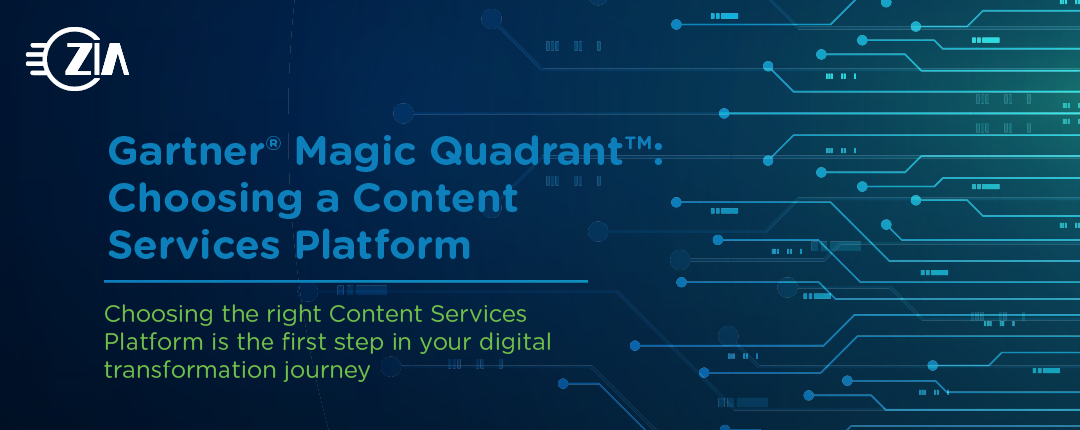Choosing the right Content Services Platform is the first step in your digital transformation journey
Digital transformation is the adoption of digital technology by a company in order to improve efficiency, value, and/or innovation. It involves the integration of digital technology into all areas of a business, fundamentally changing how the business operates and delivers value to customers. One of the most significant impacts of digital transformation is being able to revolutionize unstructured information into actionable content. This is a primary function of the work we do at Zia Consulting. We make your life easier and teach you how we did it along the way. Digital transformation also involves a cultural change that requires organizations to continually challenge the way they have always done business. We know this can be difficult because it is very easy to be attached to the way things have always been done. That said, we also know that the only way to grow is to be open to new things and challenge the status quo. Digital transformation also requires companies to experiment and get comfortable with failure. Not everything you try is going to work, but it is part of the process and is ultimately a step to getting to the right solution. Our goal is to support your process and help you fundamentally change the way your business functions for the better. If you want to get a better understanding of the way Zia Consulting approaches digital transformation, check out our online course on the six components required to digitally transform your business.
Interpreting the Gartner® Magic Quadrant™
According to Gartner, content services platforms (CSPs) are the foundational component for the management and use of content within an organization. Employees can use CSPs to retrieve and work with content in a modern, seamless way across devices and organizational boundaries. That means, CSPs are a core component of any organization’s digital workplace strategy. For years, Zia has read and interpreted Garner’s reports on CSPs, and has seen customers have great success with digital transformation initiatives when choosing the leaders in the Magic Quadrant™.
While content services platforms have been traditionally used to satisfy operational, business-centric requirements, they are now being used for more collaborative, ad hoc, content-centric requirements. Being able to support both formal business requirements and more ad hoc, collaborative, team-based working makes a CSP a foundational component.
CSPs have several capabilities. To name a few, they can handle content, records management, metadata, reporting, and collaborative projects. Sometimes they also provide content and productivity intelligence and federation, to name a few of their capabilities. It is helpful to work with an expert consultant to assess your current systems, priorities, and organizational goals to determine which capabilities are best for you. Gartner suggests that PaaS/SaaS deployment is the most important capability to consider, given the need for organizations to move from being on-premises or private hosted solutions to true cloud deployments to modern existing implementations.
Components of the Gartner® Magic Quadrant™
There are four components to the Magic Quadrant, including (1) Leaders, (2) Challengers, (3) Visionaries, and (4) Niche Players. Below is a brief description of each.
Leaders represent those who articulate the content services vision and the ecosystems that can fulfill the vision. Typically, their product suites address all of the core and optional capabilities of a CSP. They are involved in most new purchase proposals, are successful at winning new business, and have a significant global market presence, strong partner relationships, and good customer support. They are often involved in global implementation with broad applicability across many CSP use cases. It is important to note that sometimes a smaller, more focused vendor is a better choice when looking for great support and tailoring to individual needs.
Challengers have many of the same characteristics as Leaders, but their vision is not as well-matched to Gartner’s assessment of a CSP as the foundational component of any organization’s content services. They may not be as innovative, have fewer integrations, lack presence in certain industries or geographical areas, or are unable to differentiate themselves as well as Leaders. They are often a good choice for large horizontal enterprise initiatives and may work alongside Leaders.
Visionaries have modern, innovative, and differentiated offerings. They often have a presence across diverse industries and geographical areas. However, sometimes it is difficult to scale projects, making it difficult to execute on them. Sometimes it is because they are smaller organizations with limited distribution channels, market shares and partner networks. Still, they are a good option when an organization wants to modernize and transform because they often address problems in new ways.
Niche Players are limited by both their ability to execute and the completeness of their vision. In that sense, they are more suited for niche projects that are specific to an industry, geographical area, or business function or capabilities. They are likely to focus more on a smaller, more specific vision. Sometimes, they still have a large geographical presence and strong capabilities, but lack strategic importance to the vendor. They have a tendency to lose market share and only those with a market presence were included in this research. They can be a great option when you are implementing a niche solution for an organization.
The report provides the vendor strengths and cautions for a 18 companies, including AODocs, Box, DocuWare, d.velop, Fabasoft, Hyland, IBM, iManage, Intalio, Kyocera Document Solutions, Laserfiche, M-Files, Microsoft, NetDocuments, Newgen, Objective, OpenText, and SER Group. Download this report to get specific information and access fit for each of these companies.
Zia Consulting has been an award-winning partner of Hyland Alfresco since 2009.

